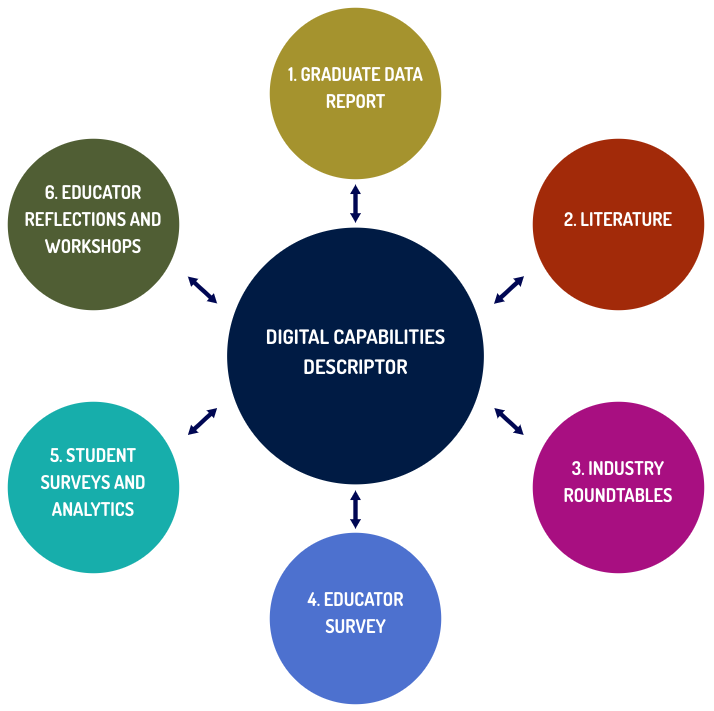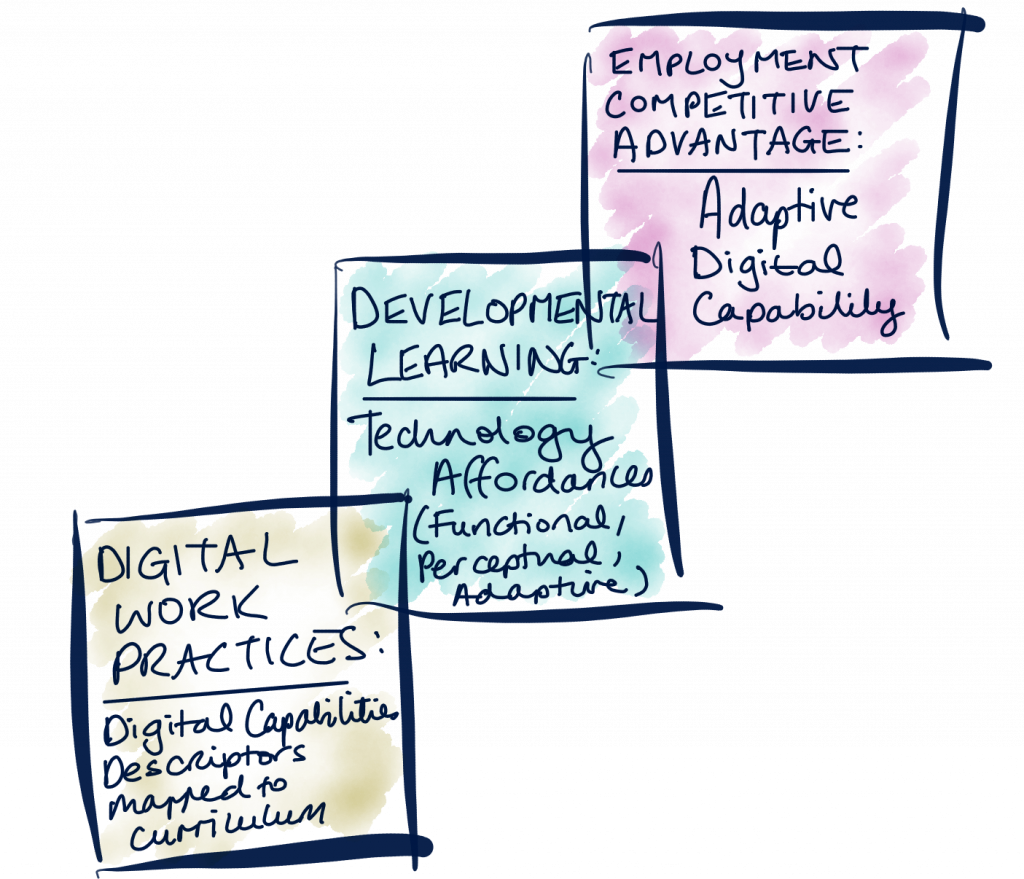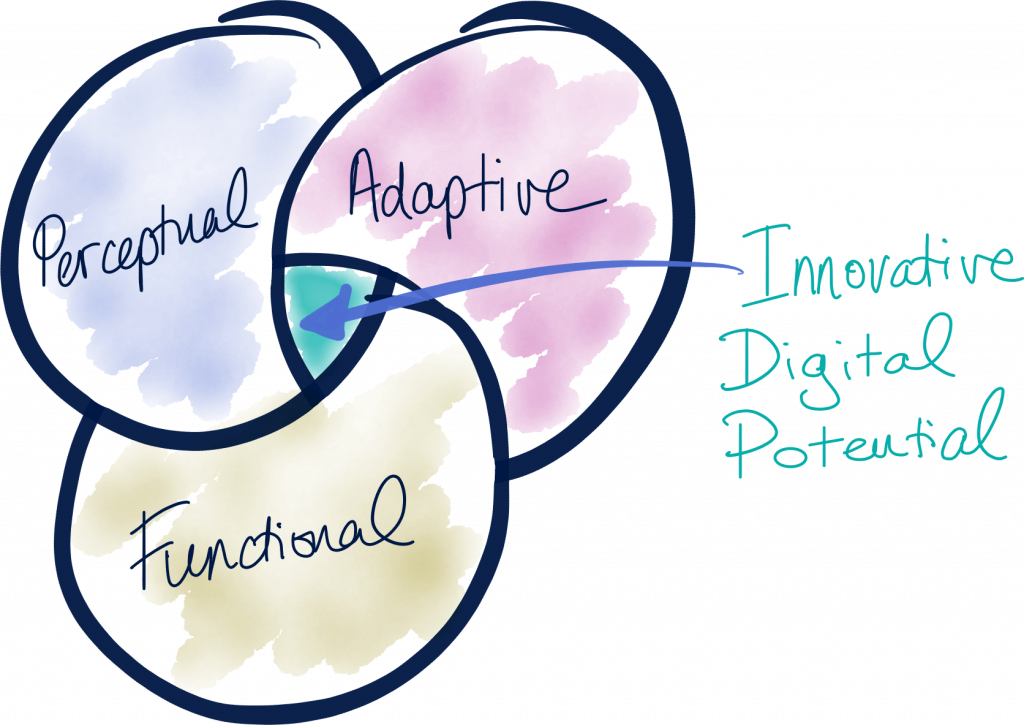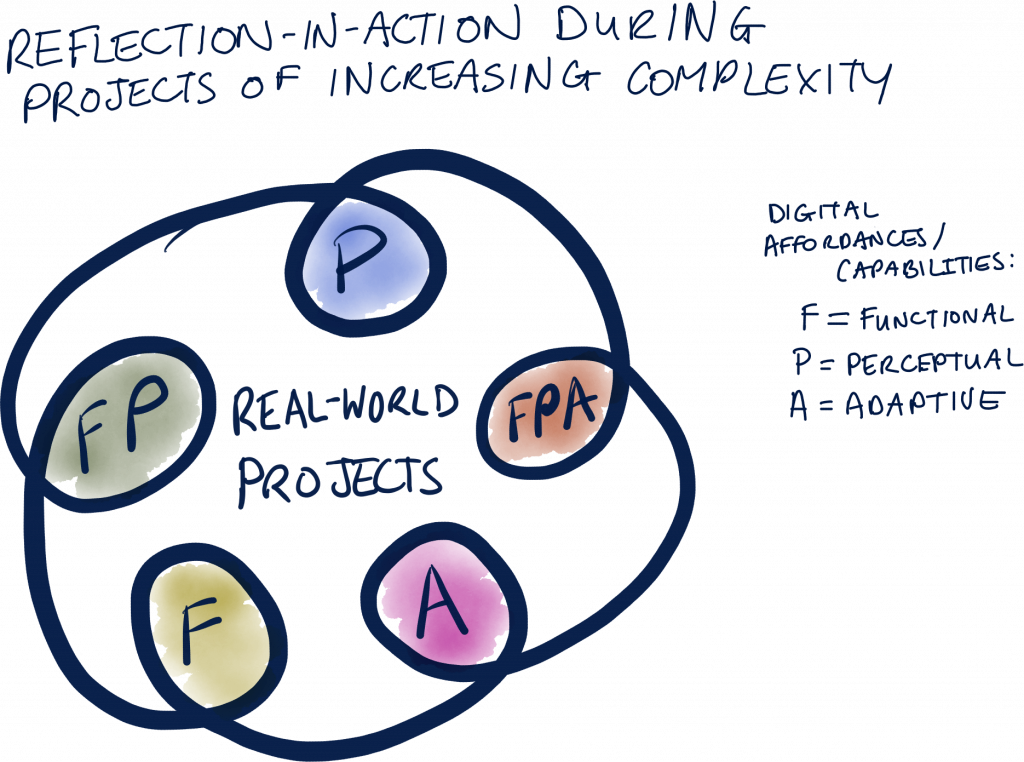WorkSHOP Part 1: AN introduction to the learning model
AIM:
- Discuss what the learning model is and why it was developed
- Explore how the learning model could be applied broadly and in your own situation
suggested content structure:
1.1. Provide a brief overview of how the learning model was developed
This learning model was developed as part of the Australian Technology Network of Universities (ATN) funded project Digital work practices: where are the jobs, what are they, and how prepared are graduates? The learning model can be applied potentially across disciplines.
The project was led by A/Professor Fiona Peterson, School of Media and Communication, RMIT University. The Project Partners were RMIT University, Queensland University of Technology, and University of Technology Sydney.
Digital Capabilities Descriptors for practice domains (e.g., Data) were developed and defined through a multi-method and iterative process that included analysis of graduate data, literature review, industry roundtables, student and educator surveys, educator reflections and workshops. Digital Capabilities Descriptors were developed for samples of Journalism, Design, Engineering and Music Industry.
Figure 1: Development and refinement of Digital Capabilities Descriptors
Industry roundtables identified that data is a key topic – generating data but especially making sense of data to inform strategic decision making AND customer experience/engagement. Grappling with Artificial Intelligence (AI) and Machine Learning (ML) has also emerged as a significant issue – requiring Adaptive digital capability, which is in high demand but short supply.
Resources
See project reports for more information:
Digital futures: what employers want from graduates (Industry Roundtables 1-4 Report)
‘Connecting the dots’ between industry and higher education: the evolving landscape of digital work (Industry Roundtables 1-5 and Employment/Labour Insights Data Report)
1.2. Walkthrough the key parts of the learning model
- Handout
- Positioning graduates for digital work futures (Learning Model and Student Pilots Report)
- Key Findings webpage
The Digital Affordance Developmental Learning Model connects digital work practices to the curriculum, through mapping Digital Capabilities Descriptors written in consultation with industry. The Descriptors interpret digital work practices through technology affordance lenses (Functional, Perceptual and Adaptive) for developmental learning about digital work practices.
Graduates who have developed Adaptive digital capability, in particular, potentially have a competitive advantage for graduate employment. Adaptive digital capability is in high demand and short supply, according to the analysis undertaken in this project.
Figure 2: Digital Affordances Development Model
PRESENT the project’s DEFINITION of ‘digital capabilities’:‘digital capabilities’ include the knowledge, skills and attributes required for a user to interact productively with technology.
DISCUSS how “digital capabilities” are viewed by participants.
What does “digital capabilities” mean for you, in your context?
INTRODUCE the Digital Affordances model. The model is designed for learners to make the most of technology, by learning to integrate three types of digital affordance/capability: Functional, Perceptual and Adaptive. These come together to build Innovative Digital Potential.
Figure 3: Digital Affordances
Then, define each of the affordances:
- Functional affordances relate to the operation of technology; this includes naming, knowing and operating the features of a technology/technologies to perform tasks.
- Perceptual affordances relate to interpretation and being discerning about technology tools and practices for their suitability and in-context operation for outcomes in known contexts.
- Adaptive affordances relate to imagining, adapting and extending technology use in previously unexplored and emerging contexts for innovative outcomes; this requires some functional knowledge/skills and perceptual experience.
Highlight that the difference between Perceptual and Adaptive affordances is that the former are related to outcomes in known contexts, while the latter are about working with imagination towards innovative outcomes in new and emerging contexts.
A key finding of the project is that many times educators and students are focusing on the functional, rather than perceptual and adaptive – even though it is adaptive capability that is most valued by industry.
We need to avoid assumptions about students as digital natives and therefore functional needs to be addressed. However, for the full Innovative Digital Potential goal of Adaptive to be realised, some functional knowledge/skills + perceptual experience are required. This may involve knowing enough to work with specialists, rather than having well developed Functional skills oneself.
WALKTHROUGH an example/s of digital affordances to illustrate what they mean in practice.
See Digital Descriptors webpage for examples.
Note that this model is NOT just LINEAR. Over time, the learner ideally develops digital capabilities across these three hierarchical but integrated layers.
Figure 4: Reflection-in-Action for Building Adaptive Capability
Reflection-in-action (Schön 1983) is integral to this learning process.
1.3. Introduce examples/case studies of where educators have used the model
For examples, see the project website. Link.
1.4. Discuss the changes to your industries and how the learning model might be useful in your context
Ideas for discussion questions:
- What’s happening with your industry/discipline? How are work practices changing?
- Do you think we are sufficiently preparing students for the future of work?
- How could we better prepare students?
- Do you think thinking about digital capabilities in this way (using digital affordance lenses) could help you in your teaching?
- How might you use this learning model in your teaching?
Workshop Resources
Sample Slides [PDF/PPT Download]
Handout: Learning Model [PDF Download]
Further Resources:
Positioning graduates for digital work futures (Learning Model and Student Pilots Project Report)
If you are running the topics as separate workshops, consider ending the workshop with invitation to do workshop 3, which focuses on application of the model including assessment – that was highlighted as a challenge by many colleagues at the Educator Workshops, especially for Adaptive digital capability.



